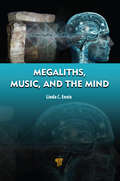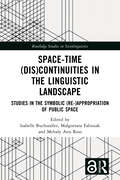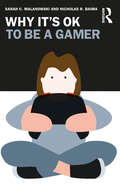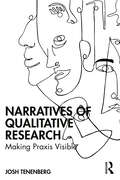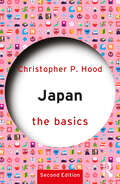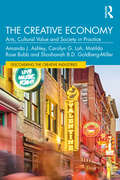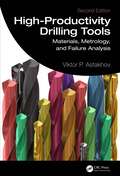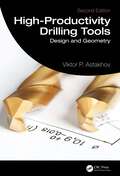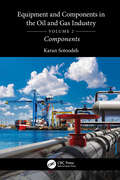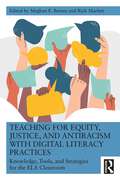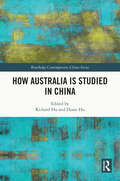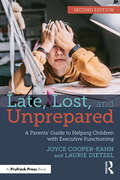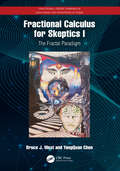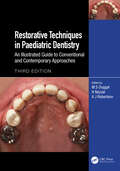- Table View
- List View
Megaliths, Music, and the Mind: A Transdisciplinary Exploration of Archaeoacoustics
by Linda EneixWhat drove the building of the first megalithic monuments and lifestyle changes that launched Western civilization? This exploration of the human experience of special sound in ancient ritual and ceremonial spaces brings a new perspective for anyone with an interest in prehistory and human development in its most pivotal days. From Göbekli Tepe in Anatolia to megalithic temples in Malta to passage tombs in Ireland, the world’s oldest buildings and the newest scientific research combine for a look at the Western Neolithic Revolution that goes where no one has gone before. With original photos and illustrations, Megaliths, Music and the Mind assembles content from the worlds of archaeology, architecture, anthropology, ethnomusicology, genetics, neuroscience, physics, and more. Fascinating pieces of evidence are set side by side, resulting in a stunning premise. This book is a core overview focused on the rediscovery of an ill-understood sensory element of developing culture, with hope for therapeutic application in the modern world. Material from the out-of-print booklet Listening for Ancient Gods has been expanded and updated in this volume, which also includes select papers from OTSF Archaeoacoustics International Conferences, plus a personal account from one of the founding fathers of new-age music.
Megaliths, Music, and the Mind: A Transdisciplinary Exploration of Archaeoacoustics
by Linda EneixWhat drove the building of the first megalithic monuments and lifestyle changes that launched Western civilization? This exploration of the human experience of special sound in ancient ritual and ceremonial spaces brings a new perspective for anyone with an interest in prehistory and human development in its most pivotal days. From Göbekli Tepe in Anatolia to megalithic temples in Malta to passage tombs in Ireland, the world’s oldest buildings and the newest scientific research combine for a look at the Western Neolithic Revolution that goes where no one has gone before. With original photos and illustrations, Megaliths, Music and the Mind assembles content from the worlds of archaeology, architecture, anthropology, ethnomusicology, genetics, neuroscience, physics, and more. Fascinating pieces of evidence are set side by side, resulting in a stunning premise. This book is a core overview focused on the rediscovery of an ill-understood sensory element of developing culture, with hope for therapeutic application in the modern world. Material from the out-of-print booklet Listening for Ancient Gods has been expanded and updated in this volume, which also includes select papers from OTSF Archaeoacoustics International Conferences, plus a personal account from one of the founding fathers of new-age music.
Space-Time: Studies in the Symbolic (Re-)appropriation of Public Space (Routledge Studies in Sociolinguistics)
by Isabelle Buchstaller, Małgorzata Fabiszak, and Melody Ann RossThis collection spotlights the diachronic dimensions of the linguistic landscape, the importance of exploring temporal dissonances in historical events in order to better understand semiotic, political, and social transformations across different communities over the last century.The volume seeks to expand the current borders of linguistic landscape (LL) research by situating the analysis of signs in the LL within their time–space organization, which has been understudied in existing scholarship. The book, featuring chapters from established and emerging scholars, argues that a focus on the historicity of the city text can reveal unique insights into the role of semiotic processes as precursors and support mechanisms for political and social changes. The collection is structured around different temporal clusters and geographic contexts across the globe where shorter and longer waves of politically driven resemioticization can be most sharply observed – post-colonial communities; post-communist societies; and recent and current sociopolitical upheavals. Taken together, the volume proposes a kaleidoscope view of the complex temporalities that underpin multimodal discourses in contested public spaces, offering new directions for LL research.This book will be of interest to students and scholars in sociolinguistics, discourse analysis, semiotics, visual anthropology, and political science.The Introduction and Chapter 8 of this book is freely available as a downloadable Open Access PDF at http://www.taylorfrancis.com under a Creative Commons Attribution-Non Commercial-No Derivatives (CC-BYNC-ND) 4.0 license.
Why It's OK to Be a Gamer (Why It's OK)
by Sarah C. Malanowski Nicholas R. BaimaIf you enjoy video games as a pastime, you are certainly not alone—billions of people worldwide now play video games. However, you may still find yourself reluctant to tell others this fact about yourself. After all, we are routinely warned that video games have the potential to cause addiction and violence. And when we aren’t being warned of their outright harms, we are told we should be doing something better with our time, like going outside, socializing with others, or reading a book. Playing video games is thus often seen at best as a waste of time, and at worst a source of violent tragedy.Why It’s OK to Be a Gamer takes on the pervasive assumption that playing video games is a childish and time-wasting hobby, and a potentially addictive and dangerous one at that. It argues instead that there are many ways in which gaming can help us flourish, for example by: developing genuine friendships and other meaningful relationships with others, helping us cultivate a virtuous personal character, giving us a unique aesthetic experience, providing us with psychological benefits, and just plain helping us relax and enjoy ourselves. Video games are not just for those with no life; on the contrary, they can help contribute to a rich and meaningful life.Key Features Introduces the philosophy of video games in a humorous and lively way with lots of engaging examples Defends gaming through a virtue theoretic approach Discusses contemporary psychology and neuroscience literature on gaming Includes discussion of gamers, video games, and common experiences of gaming
Why It's OK to Be a Gamer (Why It's OK)
by Sarah C. Malanowski Nicholas R. BaimaIf you enjoy video games as a pastime, you are certainly not alone—billions of people worldwide now play video games. However, you may still find yourself reluctant to tell others this fact about yourself. After all, we are routinely warned that video games have the potential to cause addiction and violence. And when we aren’t being warned of their outright harms, we are told we should be doing something better with our time, like going outside, socializing with others, or reading a book. Playing video games is thus often seen at best as a waste of time, and at worst a source of violent tragedy.Why It’s OK to Be a Gamer takes on the pervasive assumption that playing video games is a childish and time-wasting hobby, and a potentially addictive and dangerous one at that. It argues instead that there are many ways in which gaming can help us flourish, for example by: developing genuine friendships and other meaningful relationships with others, helping us cultivate a virtuous personal character, giving us a unique aesthetic experience, providing us with psychological benefits, and just plain helping us relax and enjoy ourselves. Video games are not just for those with no life; on the contrary, they can help contribute to a rich and meaningful life.Key Features Introduces the philosophy of video games in a humorous and lively way with lots of engaging examples Defends gaming through a virtue theoretic approach Discusses contemporary psychology and neuroscience literature on gaming Includes discussion of gamers, video games, and common experiences of gaming
Narratives of Qualitative Research: Making Praxis Visible
by Josh TenenbergNarratives of Qualitative Research uses a novel form of writing about how to do qualitative research called a praxis narrative. Each narrative is told from the author’s perspective in carrying out one of his past research studies in the social sciences.Told chronologically and in a first-person voice, the narratives position the reader alongside the narrator so as to vicariously experience how research happens in its situated particulars. Rather than a set of idealizations and universalized pronouncements, the author reveals what really goes on when one is in the thick of complex and challenging research studies, the points of trouble along with the successes. This will be relevant to researchers who have already undertaken one or more empirical research studies (though not necessarily using qualitative approaches) and now find themselves facing something new: a new analytic method, a new theoretical lens, a new form of data collection, a new domain of research questions, a new rhetorical approach. This requires letting go of the secure handholds of prescribed methods and responding to the contingencies that arise in the midst of the research. The reader is invited to follow along as the author makes visible his praxis of qualitative research.Unlike more conventional texts, in this unique alternative, the reader can follow the author's journey through his research studies as a way to reorient their conception of qualitative research and their own praxis of it. This is fascinating reading for qualitative researchers and students taking qualitative research courses, across the social sciences, education, and behavioural sciences.
Narratives of Qualitative Research: Making Praxis Visible
by Josh TenenbergNarratives of Qualitative Research uses a novel form of writing about how to do qualitative research called a praxis narrative. Each narrative is told from the author’s perspective in carrying out one of his past research studies in the social sciences.Told chronologically and in a first-person voice, the narratives position the reader alongside the narrator so as to vicariously experience how research happens in its situated particulars. Rather than a set of idealizations and universalized pronouncements, the author reveals what really goes on when one is in the thick of complex and challenging research studies, the points of trouble along with the successes. This will be relevant to researchers who have already undertaken one or more empirical research studies (though not necessarily using qualitative approaches) and now find themselves facing something new: a new analytic method, a new theoretical lens, a new form of data collection, a new domain of research questions, a new rhetorical approach. This requires letting go of the secure handholds of prescribed methods and responding to the contingencies that arise in the midst of the research. The reader is invited to follow along as the author makes visible his praxis of qualitative research.Unlike more conventional texts, in this unique alternative, the reader can follow the author's journey through his research studies as a way to reorient their conception of qualitative research and their own praxis of it. This is fascinating reading for qualitative researchers and students taking qualitative research courses, across the social sciences, education, and behavioural sciences.
Japan: The Basics (The Basics)
by Christopher P. HoodJapan: The Basics is an engaging introduction to the culture, society, and global positioning of Japan. Starting by looking at the common stereotypes, clichés, and tropes associated with Japan, this accessible introduction to the country is designed to arm readers with key skills and knowledge for their study of Japan. This new edition covers topics including: How do we go about studying Japan? What can be learnt about Japan from looking at its transportation system? What is the impact of an aging society? What are the connections between popular culture and wider Japanese society? How does Japan respond to disasters? How are core values about identity formed and what are their implications? How did Japan respond to the COVID-19 pandemic? With exercises, discussion points, and reflective questions throughout, Japan: The Basics is an ideal starting point for all those studying Japan.
Japan: The Basics (The Basics)
by Christopher P. HoodJapan: The Basics is an engaging introduction to the culture, society, and global positioning of Japan. Starting by looking at the common stereotypes, clichés, and tropes associated with Japan, this accessible introduction to the country is designed to arm readers with key skills and knowledge for their study of Japan. This new edition covers topics including: How do we go about studying Japan? What can be learnt about Japan from looking at its transportation system? What is the impact of an aging society? What are the connections between popular culture and wider Japanese society? How does Japan respond to disasters? How are core values about identity formed and what are their implications? How did Japan respond to the COVID-19 pandemic? With exercises, discussion points, and reflective questions throughout, Japan: The Basics is an ideal starting point for all those studying Japan.
The Creative Economy: Arts, Cultural Value and Society in Practice (Discovering the Creative Industries)
by Amanda J. Ashley Carolyn G. Loh Matilda Rose Bubb Shoshanah B.D. Goldberg-MillerThe creative economy permeates our everyday lives, shaping where we live, what we buy, and how we interact with others. Looking at dimensions of people, place, policy, and market forces, the book offers a comprehensive perspective on arts and culture, in both economic and social life.The book explores the multifaceted components that make up this complex field. Underlying this journey is the throughline of diversity, equity, and inclusion as watchwords of today’s global paradigm. Capital, gentrification, pay disparities, and the hegemonic confines of cultural production are a few of the key issues analyzed. Using case studies and stories of artists and creatives from the worlds of fashion, design, music, and the media arts, the book also delves into gastronomy, literature, architecture, and theatre—presenting a nuanced look at the ways in which the creative sector impacts the world today. Readers will benefit from features such as key takeaways, discussion questions, and activities, throughout the chapters.Students, scholars, policymakers, and the general public will find this a valuable resource. This book offers the reader a chance not only to understand the cultural and creative industries, but to internalize its elements and embrace the creative spirit that imbues the sector.
The Creative Economy: Arts, Cultural Value and Society in Practice (Discovering the Creative Industries)
by Amanda J. Ashley Carolyn G. Loh Matilda Rose Bubb Shoshanah B.D. Goldberg-MillerThe creative economy permeates our everyday lives, shaping where we live, what we buy, and how we interact with others. Looking at dimensions of people, place, policy, and market forces, the book offers a comprehensive perspective on arts and culture, in both economic and social life.The book explores the multifaceted components that make up this complex field. Underlying this journey is the throughline of diversity, equity, and inclusion as watchwords of today’s global paradigm. Capital, gentrification, pay disparities, and the hegemonic confines of cultural production are a few of the key issues analyzed. Using case studies and stories of artists and creatives from the worlds of fashion, design, music, and the media arts, the book also delves into gastronomy, literature, architecture, and theatre—presenting a nuanced look at the ways in which the creative sector impacts the world today. Readers will benefit from features such as key takeaways, discussion questions, and activities, throughout the chapters.Students, scholars, policymakers, and the general public will find this a valuable resource. This book offers the reader a chance not only to understand the cultural and creative industries, but to internalize its elements and embrace the creative spirit that imbues the sector.
High-Productivity Drilling Tools: Materials, Metrology, and Failure Analysis
by Viktor P. AstakhovThis completely updated volume covers tool materials, tolerances, an inspection of drilling tools, requirements of tool drawings with examples, and methodologies and procedures of failure analysis. It introduces a new line of HP drilling tools called VPA designs and brings it into sharp focus signifying its importance in drilling operations.High-Productivity Drilling Tools: Materials, Metrology, and Failure Analysis further develops the concept of the metrology of the drilling tools introduced in the first edition. For the first time, the relevant metrological parameters are clearly defined with tolerance for HPHD with practical examples of step-by-step inspection/measurement using advanced tool measurement microscopes and CNC machines. A pros and cons list as a quick and easy decision-making tool for the choice of measuring equipment for a particular application is offered along with practical examples of drilling tool drawings to help tool designers, cutting tool and manufacturing engineers, and users in their everyday activities in the design and selection of HPDT for a particular application. An unparalleled presentation of metalworking fluids (MWFs, a.k.a. coolants) is given and covers all the start of the business: selection, implementation in HPDT and drilling operation, monitoring, and maintenance. A two-step procedure for successful implementation of near-dry machining (NDM) or minimum quantity lubrication (MQL) is presented, and a discussion of the wear of the drilling tool, its proper assessments, and metrics are provided in the evaluation of tool life and quality of machined holes.This practical book should be on the shelves of all industrial engineers, those working in production and manufacturing, process designers, tool material designers, cutting tool designers, and quality specialists. Researchers, senior undergraduate students, and graduate students will also find this book full of very helpful reference information and the source of new ideas and notions in drilling tool development.
High-Productivity Drilling Tools: Design and Geometry
by Viktor P. AstakhovThis completely updated volume covers the design, manufacturing, and inspection of high‑productivity drilling tools (HPDT) and addresses common issues with drilling system components. It discards old notions and beliefs as it introduces scientifically and technically sound concepts and rules with detailed explanations and multiple practical examples.High‑Productivity Drilling Tools: Design and Geometry introduces the development of the concept of high‑productivity (HP) drill design and its manufacturing and application features. This book continues to develop the concept of a drilling system in the new edition and includes new practical examples. It explains how to properly design and manufacture drilling tools for a specific application and includes a detailed explanation of the design features, tool manufacturing and implementation practices, metrology of drilling and drilling tools, and the tool failure analysis. Using the coherency law as the guidelines introduced in the first edition, the new edition shows how to formulate the requirements for the components of the drilling system, pointing out that the drilling tool is the key component to be improved.This practical book should be on the shelves of all industrial engineers, those working in production and manufacturing, process designers, tool material designers, cutting tool designers, and quality specialists. Researchers, senior undergraduate students, and graduate students will also find this book full of very helpful reference information.
High-Productivity Drilling Tools: Materials, Metrology, and Failure Analysis
by Viktor P. AstakhovThis completely updated volume covers tool materials, tolerances, an inspection of drilling tools, requirements of tool drawings with examples, and methodologies and procedures of failure analysis. It introduces a new line of HP drilling tools called VPA designs and brings it into sharp focus signifying its importance in drilling operations.High-Productivity Drilling Tools: Materials, Metrology, and Failure Analysis further develops the concept of the metrology of the drilling tools introduced in the first edition. For the first time, the relevant metrological parameters are clearly defined with tolerance for HPHD with practical examples of step-by-step inspection/measurement using advanced tool measurement microscopes and CNC machines. A pros and cons list as a quick and easy decision-making tool for the choice of measuring equipment for a particular application is offered along with practical examples of drilling tool drawings to help tool designers, cutting tool and manufacturing engineers, and users in their everyday activities in the design and selection of HPDT for a particular application. An unparalleled presentation of metalworking fluids (MWFs, a.k.a. coolants) is given and covers all the start of the business: selection, implementation in HPDT and drilling operation, monitoring, and maintenance. A two-step procedure for successful implementation of near-dry machining (NDM) or minimum quantity lubrication (MQL) is presented, and a discussion of the wear of the drilling tool, its proper assessments, and metrics are provided in the evaluation of tool life and quality of machined holes.This practical book should be on the shelves of all industrial engineers, those working in production and manufacturing, process designers, tool material designers, cutting tool designers, and quality specialists. Researchers, senior undergraduate students, and graduate students will also find this book full of very helpful reference information and the source of new ideas and notions in drilling tool development.
High-Productivity Drilling Tools: Design and Geometry
by Viktor P. AstakhovThis completely updated volume covers the design, manufacturing, and inspection of high‑productivity drilling tools (HPDT) and addresses common issues with drilling system components. It discards old notions and beliefs as it introduces scientifically and technically sound concepts and rules with detailed explanations and multiple practical examples.High‑Productivity Drilling Tools: Design and Geometry introduces the development of the concept of high‑productivity (HP) drill design and its manufacturing and application features. This book continues to develop the concept of a drilling system in the new edition and includes new practical examples. It explains how to properly design and manufacture drilling tools for a specific application and includes a detailed explanation of the design features, tool manufacturing and implementation practices, metrology of drilling and drilling tools, and the tool failure analysis. Using the coherency law as the guidelines introduced in the first edition, the new edition shows how to formulate the requirements for the components of the drilling system, pointing out that the drilling tool is the key component to be improved.This practical book should be on the shelves of all industrial engineers, those working in production and manufacturing, process designers, tool material designers, cutting tool designers, and quality specialists. Researchers, senior undergraduate students, and graduate students will also find this book full of very helpful reference information.
Equipment and Components in the Oil and Gas Industry Volume 2: Components
by Karan SotoodehEquipment and Components in the Oil and Gas Industry Volume 2: Components provides an overview of the components used in the oil and gas industry, including instrumentation, pipe components, and safety components. Using practical industry examples and an accessible approach, the book is a key reference point for those seeking to learn more about the industry.Covering both larger and smaller components used throughout the oil and gas industry, the book details the theory behind pressure gauges, temperature gauges, flow gauges, and level gauges. It then goes on to discuss piping components, such as pipes, flanges, and gaskets and introduces piping special components. Valves are particularly crucial to the oil and gas industry, including on/off valves, control valves, safety valves, and special valves. The book also details actuators, sprinklers, fire and gas detectors, hoses, and hose reels, along with electrical components such as switches, cables, wires, and cable glands. Finally, the book ends with a discussion of heating, ventilation, and air conditioning (HVAC) components.This book will be of interest to mechanical and chemical engineers working in the oil and gas industry.
Equipment and Components in the Oil and Gas Industry Volume 2: Components
by Karan SotoodehEquipment and Components in the Oil and Gas Industry Volume 2: Components provides an overview of the components used in the oil and gas industry, including instrumentation, pipe components, and safety components. Using practical industry examples and an accessible approach, the book is a key reference point for those seeking to learn more about the industry.Covering both larger and smaller components used throughout the oil and gas industry, the book details the theory behind pressure gauges, temperature gauges, flow gauges, and level gauges. It then goes on to discuss piping components, such as pipes, flanges, and gaskets and introduces piping special components. Valves are particularly crucial to the oil and gas industry, including on/off valves, control valves, safety valves, and special valves. The book also details actuators, sprinklers, fire and gas detectors, hoses, and hose reels, along with electrical components such as switches, cables, wires, and cable glands. Finally, the book ends with a discussion of heating, ventilation, and air conditioning (HVAC) components.This book will be of interest to mechanical and chemical engineers working in the oil and gas industry.
Teaching for Equity, Justice, and Antiracism with Digital Literacy Practices: Knowledge, Tools, and Strategies for the ELA Classroom
by Meghan E. Barnes Rick MarlattTo embrace today’s culturally and linguistically diverse secondary English Language Arts (ELA) classrooms, this text presents ways in which teachers can use digital tools in the service of antiracist teaching and developing equity-oriented mindsets in teaching and learning.Addressing how the use of digital tools and literacy practices can be woven into current ELA curricula, and with consistent sections, each chapter covers a different aspect of digital tool use, including multimodal texts, critical media literacies, connection-building, and digital composing. Understanding that no classroom is a monolith, Barnes and Marlatt’s timely text presents practical applications and resources suitable for different environments, including urban and rural contexts.The volume is essential reading in courses on ELA/literacy methods and multicultural education.
Teaching for Equity, Justice, and Antiracism with Digital Literacy Practices: Knowledge, Tools, and Strategies for the ELA Classroom
by Meghan E. Barnes Rick MarlattTo embrace today’s culturally and linguistically diverse secondary English Language Arts (ELA) classrooms, this text presents ways in which teachers can use digital tools in the service of antiracist teaching and developing equity-oriented mindsets in teaching and learning.Addressing how the use of digital tools and literacy practices can be woven into current ELA curricula, and with consistent sections, each chapter covers a different aspect of digital tool use, including multimodal texts, critical media literacies, connection-building, and digital composing. Understanding that no classroom is a monolith, Barnes and Marlatt’s timely text presents practical applications and resources suitable for different environments, including urban and rural contexts.The volume is essential reading in courses on ELA/literacy methods and multicultural education.
How Australia is Studied in China (ISSN)
by Richard Hu Diane HuChina has arguably the largest community of Australian studies in the world. However, not much is known about this phenomenon, including its emergence, rationale, interests, influences, and the implications for strategic Australia-China engagement in a region of increasing challenge and uncertainty. This volume unpacks how Australia is taught, learnt, researched, communicated, and promoted in the Asian giant as well as its largest trade partner. In doing so, it penetrates the representation and essence of this phenomenon to seek both the ‘Australianness’ and the ‘Chineseness’ in it.This volume collects contributions from a group of leading and emerging Chinese and Australian scholars—who are members and insiders of this community—to jointly debate on this intellectual entity and its significant influences and implications. Produced at a critical moment of commemorating half a century of China-Australia diplomatic relations and four decades of formalised Australian studies in China, this volume provides an up-to-date, comprehensive, and insightful examination of this Australia-China engagement.It will be of interest to scholars, students, policymakers, and general readers in areas of Australian studies, Chinese studies, Asia-Pacific studies, China-Australia relations, and international relations.
Late, Lost, and Unprepared: A Parents’ Guide to Helping Children with Executive Functioning
by Joyce Cooper-Kahn Laurie DietzelDoes your child have difficulty meeting deadlines, staying organized, or keeping track of important information? Do they tend to forget details? Are they prone to emotional meltdowns? This book will become your go-to, all-inclusive guide to helping children manage issues with these executive functions, a set of related yet distinct mental skills that allow us to stay on target as we work toward our goals.Packed with encouragement, strategies, overviews, case studies, tips, and more, this newly revised edition offers science-based information explained in accessible, everyday language. You will find down to earth examples and a flexible framework that allows you to think on your feet and adapt the strategies to any child or situation.In addition to providing approaches for helping your child to manage demands in the short run, this book offers strategies for building independent skills for long-term self-management. Covering what you need to know, as well as what you can do, Late, Lost, and Unprepared gives parents the support they need to help their child become productive and independent – today and in the future.
Fractional Calculus for Skeptics I: The Fractal Paradigm (Fractional Order Thinking in Exploring the Frontiers of STEM)
by Bruce J. West YangQuan ChenThis book is the first of its kind on fractional calculus (FC), dedicated to advocating for FC in STEM education and research.Fractional calculus is increasingly used today, but there remains a core population of skeptics regarding the utility of this "new" calculus. This book is intended for those who are skeptical about the need for fractional calculus to describe dynamic complex networks and must be convinced of its use on a case-by-case basis. It is a one-stop resource to rapidly read and replace the appropriate skepticism with new knowledge. It offers compelling reasons from the perspectives of the physical, social, and life sciences as to why fractional calculus is needed when addressing the complexity of an underlying STEM phenomenon. The six chapters are accompanied by useful and essential appendices and chapter-end references. Each includes new (fractional-order) ways of thinking about statistics, complexity dynamics, and what constitutes a solution to a complexity science problem.The book will appeal to students and researchers in all STEM-related fields, such as engineering, physics, biology and biomedicine, climate change, big data, and machine learning. It is also suitable for general readers interested in these fields.
Late, Lost, and Unprepared: A Parents’ Guide to Helping Children with Executive Functioning
by Joyce Cooper-Kahn Laurie DietzelDoes your child have difficulty meeting deadlines, staying organized, or keeping track of important information? Do they tend to forget details? Are they prone to emotional meltdowns? This book will become your go-to, all-inclusive guide to helping children manage issues with these executive functions, a set of related yet distinct mental skills that allow us to stay on target as we work toward our goals.Packed with encouragement, strategies, overviews, case studies, tips, and more, this newly revised edition offers science-based information explained in accessible, everyday language. You will find down to earth examples and a flexible framework that allows you to think on your feet and adapt the strategies to any child or situation.In addition to providing approaches for helping your child to manage demands in the short run, this book offers strategies for building independent skills for long-term self-management. Covering what you need to know, as well as what you can do, Late, Lost, and Unprepared gives parents the support they need to help their child become productive and independent – today and in the future.
Fractional Calculus for Skeptics I: The Fractal Paradigm (Fractional Order Thinking in Exploring the Frontiers of STEM)
by Bruce J. West YangQuan ChenThis book is the first of its kind on fractional calculus (FC), dedicated to advocating for FC in STEM education and research.Fractional calculus is increasingly used today, but there remains a core population of skeptics regarding the utility of this "new" calculus. This book is intended for those who are skeptical about the need for fractional calculus to describe dynamic complex networks and must be convinced of its use on a case-by-case basis. It is a one-stop resource to rapidly read and replace the appropriate skepticism with new knowledge. It offers compelling reasons from the perspectives of the physical, social, and life sciences as to why fractional calculus is needed when addressing the complexity of an underlying STEM phenomenon. The six chapters are accompanied by useful and essential appendices and chapter-end references. Each includes new (fractional-order) ways of thinking about statistics, complexity dynamics, and what constitutes a solution to a complexity science problem.The book will appeal to students and researchers in all STEM-related fields, such as engineering, physics, biology and biomedicine, climate change, big data, and machine learning. It is also suitable for general readers interested in these fields.
Restorative Techniques in Paediatric Dentistry: An Illustrated Guide to Conventional and Contemporary Approaches
One of the first books on the market to illustrate the various clinical techniques for restoration, this revised and updated new edition offers new material on treatment planning, local analgesia, biomaterials, biological and contemporary approaches, and aesthetic crowns. The book addresses the specific needs of the paediatric patient and helps the clinician manage the restoration with those needs in mind. As a classic volume, it is essential for every dentist working with children and adolescent patients.
